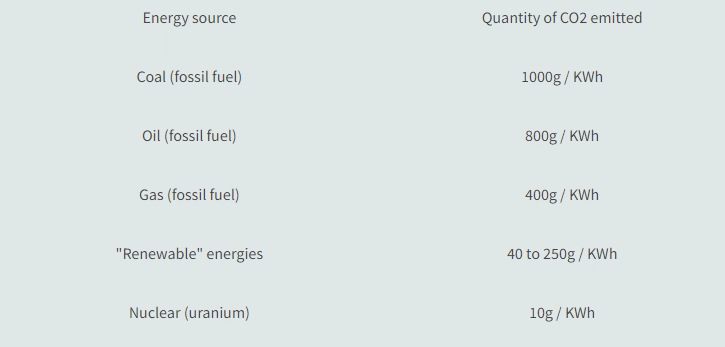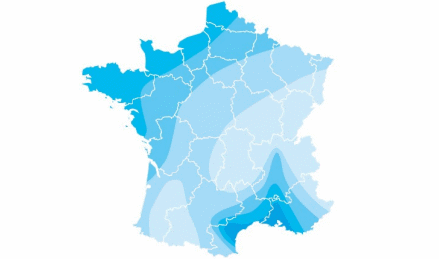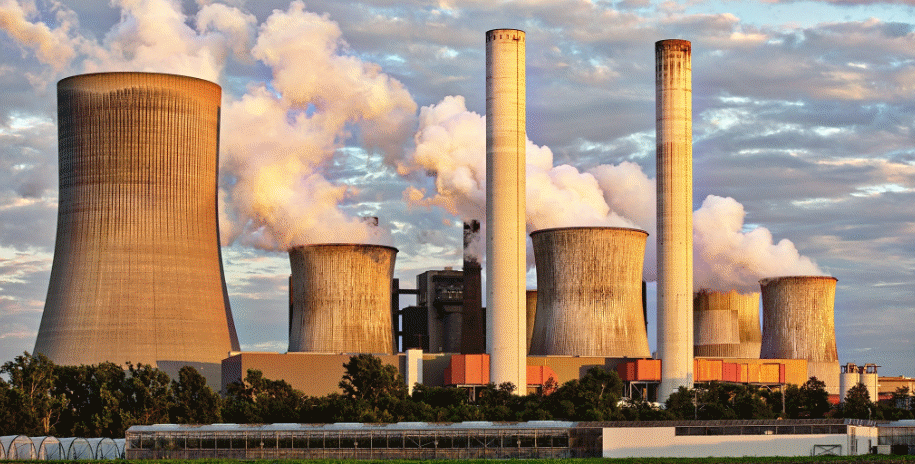The 2021 UN conference on climate change (COP26) has recently concluded in Glasgow, leaving the problem well and truly unresolved. Forecasts based on the conference outcome show the world heading for temperature 2.4oC above pre-industrial levels. Left Horizons would like to promote a discussion amongst socialists on climate change policy, including the merits and dangers of nuclear power.
Nuclear power produces minimal greenhouse gas (GHG) emissions, except in the manufacture of plant in the first place, so should it be part of the solution, even if just on an interim basis?
As a contribution to this debate, we re-publish below extracts from an article by Gauthier Hordel in the French Marxist paper, La Riposte. The article is called Global warming and energy: the capitalist impasse. We recommend the whole article to our readers but for this article we have just picked out the sections relevant to the nuclear power debate. The original article covers many other important topics like nuclear fusion and hydrogen and analyses all these topics in the context of the incapacity of the capitalist system to deal with this challenge.
Extract 1 – greenhouse gas emissions by energy source
Based on our current knowledge, all energy sources and techniques used to produce electricity emit CO2. We know exactly how to quantify GHG emissions by energy source:

Source: BP statistical review 2018
Although it arouses rejection in activist circles, nuclear energy is the least polluting in terms of GHG emissions. Other problems come into play which will be developed further on. For example, 1g of uranium is needed to produce the same amount of energy as 1 ton of oil. The carbon footprint of renewable energies are linked to their dependence on fossil fuels in all the processes of the energy production (metal extraction, transport, manufacturing, etc).
Extract 2 – nuclear fission and waste management
With the publication of the Special Relativity Theory showing the equivalence between energy and mass, Einstein paved the way for work on nuclear energy, despite his concerns about the military use that was made of it afterwards. Several decades after this publication, we learned how to generate energy from atoms. The principle of current nuclear power plants, whatever their generation, is based on the fission of the uranium atom. This phenomenon releases a very large quantity of energy in the form of heat allowing it to turn a turbine coupled to an alternator producing electricity.
Very long lifespan of nuclear waste
The major advantage of nuclear power is that it takes a small amount of uranium to produce a large amount of energy, compared to oil, which makes it possible to emit few GHGs. This includes the entire cycle, from uranium mining to recycling waste (radioactive and non-radioactive), including electricity production. The major flaw is the management of the highly radioactive waste which has a long radioactive half-life, meaning it has a lifespan that can extend from several hundred to several thousand years. Exposure to these wastes is very dangerous, even fatal, for living organisms. Prolonged but not fatal exposure puts you at risk of cancer.
Over time, this waste accumulates and its management requires complex logistics. The very long period of radioactivity makes it a poisoned “legacy” for future generations. In addition, our experience throughout the history of civil nuclear power has demonstrated the risks and irresponsibility in certain cases of managing waste, given its dangers. This problem requires a very long-term vision, incompatible with the immediacy of the capitalist system which demands short-term profitability.
During the period 1946-1993, part of the waste was simply thrown at sea, until that practice was banned by an international treaty. The idea behind this practice was that the sea represented a “relative” barrier to radioactivity, which is fair, and that there would be a slow dilution thanks to the protection of the barrels in which the waste is confined. However, the barrels undergo erosion from the salty sea water and the dilution has nothing to do with it. On the other hand, dilution can only work as long as there is a finite amount of waste that is dumped into the sea, which is absolutely not the case.
Nuclear waste in the English Channel
Between 1966 and 1969, England and Belgium dumped their waste off the English Channel into the Casquets pit in the north of the island of Guernsey. There are 28,000 barrels in this pit, which is only 100 to 163 m deep. The IAEA (International Atomic Energy Agency) carried out an exploration and samples revealing on the one hand that the barrels are corroded by rust and, on the other hand, that there is the presence of plutonium at extremely worrying levels in fauna and the underwater environment. There is the presence of radioactive particles such as radionuclides which are transmitted in the food chain. These particles have the effect of causing mutations in cells capable of causing cancer and being passed on to subsequent generations.
Today, since the ban on discharging barrels at sea, reprocessing centres must treat the waste or store it. But so-called “low-radioactive” atoms are found in liquid form after reprocessing and are discharged into the sea via a pipe, still on the principle of dilution. This has the advantage of being less visible to the population and anti-nuclear activists. This is the case, for example, with the nuclear waste reprocessing centre at La Hague Orano (formerly Areva): the treated waste is evacuated via a 5 km long pipe. The regulations impose a maximum radioactivity threshold for discharges but leaves it to the company to check the levels of radioactivity and to communicate the results to the ASN (Nuclear Safety Authority), that is, to carry out its own monitoring. How can we trust companies whose goal is to be as profitable as possible?
France dependence on nuclear power
France has invested heavily in nuclear power, allowing it to become the second country in the world for net electrical power (exports over imports) after the United States and first by number of inhabitants. This strategy was adopted by the French ruling class in the aftermath of the Second World War, in particular because of the French subsoil’s poverty in terms of energy resources and reinforced by the “oil shock”. The development of nuclear power allowed it to maintain relative energy sovereignty, although uranium comes from deposits located in Canada, Australia, Kazakhstan and especially Niger, a former French colony. The multinational Orano exploits uranium there, benefiting from certain tax advantages.
There could be a way to reuse the waste emitted by nuclear power production. The CEA (atomic energy commission) had a project called Astrid which aimed to build a 4th generation fast neutron nuclear reactor (RNR). The idea was to consume the accumulated stocks of uranium 238 resulting from the fission of uranium 235 and to recycle the most radiotoxic nuclear waste. However, this type of reactor requires substantial infrastructure requiring a lot of investment. As the price of uranium is currently too low, there is no economic opportunity to continue its development. This is where capitalist logic leads us.
The dangers posed by nuclear fission
Nuclear energy is a dangerous energy and unfortunately is subject to the laws of capital, that is to say of profitability and profit. In many cases, there are serious gaps in the safety aspects of both sites and personnel, such as the use of temporary workers for high exposure tasks. Waste management represents a cost incompatible with maximum profit. The three biggest accidents, Three Mile Island in the United States, Chernobyl in Ukraine and Fukushima in Japan, have caused catastrophic damage to people and the environment. These events, allied with the threat of nuclear weapons, have resulted in the development of opposition to nuclear power. According to the Statista polling institute in 2016 64% of French people had a negative opinion of nuclear energy.
Extract 3 – Annex 3 Renewable versus nuclear energies
The production of electricity from nuclear fuels is hotly debated and critiqued for both good and bad reasons. There are different anti-nuclear currents.
Some of them defend the idea of more or less gradual replacement of the estate of nuclear power by renewable energies. We will give an indication here of what this means for the replacement of nuclear power plants by wind turbines.
Hypothesis:
The data used are from EDF and RTE for 2018 and 2019. The following results are approximations made from calculations for a level of consumption equal to that of 2019.
Power and energy production of France’s wind farms 2019
Total power of the wind farms = 16.5 GW (EDF and RTE data).
Energy produced = 33.8 TWh (EDF and RTE data).
Load factor (time during which there is energy production) = 24.19% (EDF and RTE data).
Average power of a wind turbine = 2.17 MW (result based on 2018 data).
Total number of wind turbines = 7,228 (result obtained from 2019 data).
Power and energy production of France’s nuclear power plants 2019
Power = 61.4 GW (EDF and RTE data).
Energy produced = 379.5 TWh (EDF and RTE data).
Average load factor = 70.6% (result obtained from 2019 data).
How many wind turbines are required to replace the nuclear estate?
Number of wind turbines required to replace the nuclear estate = 81,153.
Total number of wind turbines required to achieve the 2019 level of power generation = 81,153 + 7,228 = 88,381.
Density of wind turbines [required?] in France (metropolitan area + overseas departments) = 1.38 wind turbines per 10 km2.
The results presented are purely indicative. They do not take into account the problems caused by the low load factor of a wind turbine that delivers energy only about 25% of the time. The calculated load factor of 70.6% for the nuclear estate is an average theoretical result for each reactor. The nuclear estate as a whole is controllable energy, that is, it is capable of delivering according to an energy schedule 100% of the time. On the other hand, wind turbines are totally dependent on weather conditions, namely the force of the wind. There are unequal winds on French territory. This means that the siting of wind turbines is concentrated in the most favorable areas, but a large part of the territory is unsuitable for hosting wind farms because of it having an extremely low load factor.
Wind speeds in km/h


The hypothesis of the replacement of the nuclear estate by wind seems compromised depending on the conditions given at the start, namely an energy consumption equivalent to that of 2019 for the following reasons:
• Firstly, the calculated wind turbine density shows that it is impossible to replace the nuclear estate without drastically reducing energy consumption on the one hand and on the other hand the problem would be aggravated by the unevenness of wind in the territory.
• Secondly, taking into account the fact that electricity is not storable and the load factor, all wind power cannot ensure the production and delivery of electricity without interruption and totally dependent on meteorological factors.
The most likely scenario for electricity consumption according to RTE’s assumptions is a big increase. It is expected to increase from 25% of total energy consumption to 55% by 2050 to offset the decline in oil and gas as part of the “fight” against global warming. This means that more electricity will have to be produced.
If the scenario of the break with nuclear power were chosen without resorting to coal, this would have a major impact on the organization of society, such as: drastic reduction in consumption, drastic limitation of the power supplied to routing points (businesses, communities, homes etc), discontinuities without control, collapse of economic activity, severe decrease in labor productivity. This situation would be aggravated by the fact that capitalism is not able to organize society without extremely brutal shocks.
Extract 4 – Towards which model of society to preserve the planet?
The question is what technology to use to ensure the vital functions of society. In view of what has been described previously, it is clear that fossil fuel must be substituted for others that emit less GHGs. The answer is not evident because between falsely “green” renewable energies and the danger of nuclear power or the waste management, there are no quick fixes. There is no totally “clean” energy production; it is a matter of compromise. Energy production necessarily generates pollution.
Free of the law of profit and of particular economic interests, a communist society will have to combine scientific knowledge, engineering, economical and ecological planning to find the essential solutions to repair the damage generated by human productive activity. Scientific knowledge lets us provide a better understanding of nature. Society freed from private interest will be able to invest heavily in research rather than for-profit innovation. The transformation of living conditions must integrate sustainable management into its equation of the planet, and this implies profound transformations, in the organization of society, people, economy, knowledge and technology to both reduce the energy consumption and at the same time find ways to generate energy with minimal impact on the environment.
Global warming concerns all the countries of the world. The most powerful countries are also the biggest contributors. Internationalism is an integral part of communism, that is, the transformation of social relations on an international scale. This approach is essential to tackle this problem on such a large scale. Communism is the only one able to provide solutions that can combine the social and economic and environmental response for the entire population by destroying private economic interests, associated wars and by mobilizing the considerable resources of society, that is, by using knowledge and collective intelligence for the transformation of society.
From an article by Gauthier Hordel in La Riposte. The original can be found here.




Why does the article not deal with solar energy, or or wave or other hydroelecrticity rather than just wind?
Reply posted on behalf of Gauthier Hordel, author of the article
In this article I partly try to indicate what are the possible consequences of the replacement of nuclear plant by another type of energy production. Of the different renewable energies, the best candidate is the wind turbine. Solar panel is an uncontrollable energy like wind turbine. When there is no sun or it’s the night, we can’t produce energy. The performance depends on the region. We could to do the calculation with solar panel but the result would have been worse than the wind turbine calculation. So the comparison with the wind turbines is the best and the most feasible.
In 2019, in the United Kingdom, hydroelectricity represents 0.4% of electricity production. In France it’s 13%. France produces more hydroelectricity than the United Kingdom because there are more mountainous regions. In France hydroelectricity is at its maximum exploitation and can’t produce more.
The other types of energy production can’t produce enough electricity to respond to the needs.